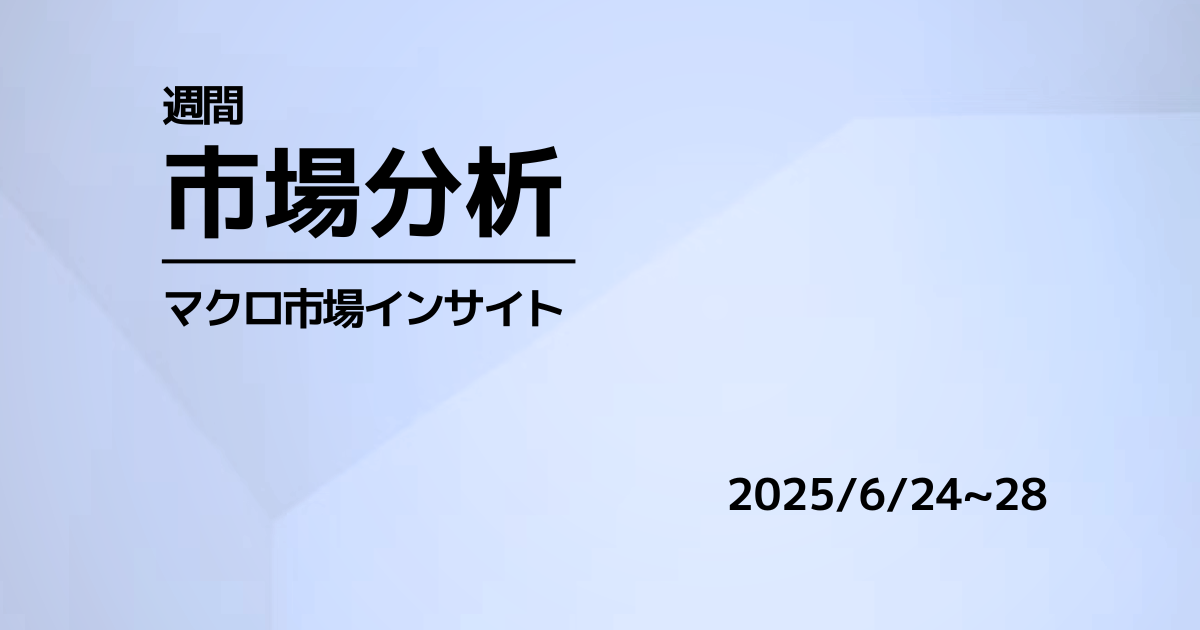This macro-market analysis is based on the fact that I (@mifseeThis is a record of my personal study to gain a bird's eye view of the daily macro environment when making investment decisions in the U.S. market. The contents may contain errors or differences from the actual situation. Please be aware of this before reading this report.
market insight
general mood
This week (June 24-28), global markets saw a simultaneous "stock rally + safe asset shift" triggered by reports of an Israeli-Iranian ceasefire and a tailwind of lower oil prices, lower interest rates, and a weaker dollar.
The S&P 500 hit a new all-time high on a closing basis, and the Nasdaq Composite solidified the 20,000 point level, while the Nikkei 225 recovered to the 40,000 level. The yield on the 10-year U.S. Treasury note fell from about 4.30% to 4.26% as fears of inflation receded due to the sharp drop in crude oil, and the dollar index (DXY) fell to a level of over -10% since the beginning of the year.
While funds continued to concentrate on "AI supply chain stocks" such as generative AI-related stocks, semiconductors, and copper, alternative assets such as gold and bitcoin were also strong, highlighting a unique market environment where risk-on and diversified investments coexist.
equity
- United States of America: S&P 500 from 6,101.76 to 6,173.07 (+1.2%) and the Nasdaq Composite from 19,912.53 to 20,273.46 (+1.8%). Generated AI-related and semiconductors led the way, hitting record highs together over the weekend.
- Japan: The Nikkei 225 recovered to the 40,000 level for the first time since January at 38,790.56 to 40,150.79 (+3.5%). Semiconductors and megabanks led the rally.
- Europe: The STOXX 600 is mostly flat, with declines in energy stocks offset by utility and travel stocks. Macro uncertainty weighs.
- Hong Kong, China: Hang Seng Index is over +4% on policy expectations. State-owned fund inflows boosted tech stocks.
bond
The U.S. 10-year yield fell from 4.30% at the beginning of the week to 4.26% at the weekend, with real rates also on a downtrend. The German 10-year fell from 2.58% to 2.55%. The yield curve continued to flatten, and there were scattered shifts of funds to longer durations. The 10-year Japanese bond moved slightly lower from 1.41% to 1.43%.
exchange (e.g. foreign)
USD/JPY fell from the ¥146 level to the low ¥144 level. Euro/dollar was at its highest level since the beginning of the year, from 1.154 to the 1.17 level, and the trend of overall dollar weakness was strengthened. However, the yen weakened against other currencies, and the yen's crosses generally remained weak.
commodity
Brent crude oil is down -5.3% for the week from $70.52 to $66.80. Copper retreated higher from $4.87 to $5.07/lb (+4.1%). Gold is slightly lower at $3,320→$3,288, but the lower dollar limits the downside.
crypto
Bitcoin maintained its highs for the year, from 106,078 to $107,044 (+0.9%), with continued inflows via ETFs. Ethereum also continued to rise from 2,245 to $2,426.
Macro Event Focus
- U.S. May PCE deflator (6/27): Core y/y expected to be 2.5%. If a downward swing, interest rate cut speculation will resurface.
- Preliminary HICP for June in Euro area (6/28): Expect ECB doves if it falls below 2%.
- OPEC+ JMMC (7/1): August production increase decision will affect crude oil volatility.
Insight Summary
- stock (company): Predominant buying is centered on generative AI and semiconductors. Selective investment in Europe and China due to policy uncertainty.
- bond: Gradual inclusion of mainly U.S.-German 10-year bonds to secure both real yield and room for price appreciation.
- commodity: Short crude oil / long copper pair working, beta suppressed while preparing for a rebound after OPEC+.
- Forex: Buy the euro and resource-rich currencies on the assumption of a weaker dollar trend. For the yen, limit trading to the short term with an eye on the intervention line.
- alternative: Maintaining a ratio of 5% gold and 2% BTC to ensure multiple hedges.



